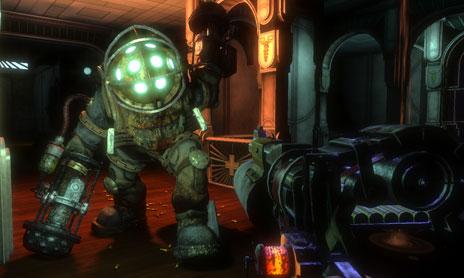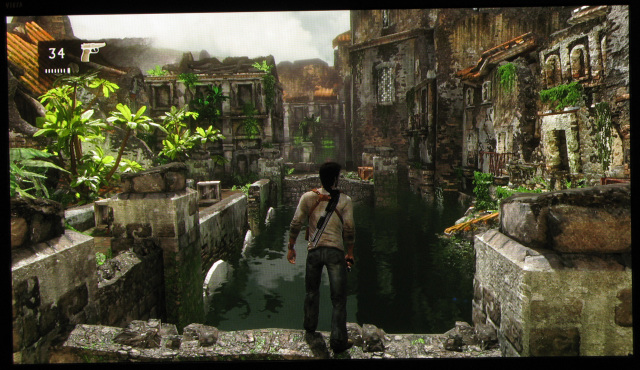Trending
Opinion: How will Project 2025 impact game developers?
The Heritage Foundation's manifesto for the possible next administration could do great harm to many, including large portions of the game development community.

Featured Blog | This community-written post highlights the best of what the game industry has to offer. Read more like it on the Game Developer Blogs or learn how to Submit Your Own Blog Post
Immersion involves more than just being a polished, graphically awesome game. The story must be engrossing. It has to touch me emotionally in some way. Perhaps it needs to play on my moral or ethical beliefs. Sounds and environment are essential.


Bioshock 2
What makes a game immersive? I asked this question of the experts on Linked In several months ago. In the meantime, I've been participating in the DP Challenge and find my own definition changing as I play. As art and story become ever more important to games such as Bioshock 2, it may be time to explore the subject more deeply.While most of us seem to agree that experience, world, addictive play, polished graphics, etc. are all essential elements of immersive play, Nancy Hoffman and Ian Shreiber pointed out that immersion could also simply be a flow state similar to the one players find themselves in during casual play, such as playing Tetris. This is a good point. In a flow state, the player becomes unaware of everything around them, immersing themselves in the experience of the game. Not only does everything else fall away, but the game becomes easier to play during this state. Therefore, while most of us don't think of immersive play in casual games, it's important to explore the flow state as an immersive play device. It would be interesting to see if we could take the flow state of a game, such as Tetris, and use it in the context of a larger and more complex game.
Beyond flow, though, how can a game become truly immersive. The one element designers can't control is fun. Everyone defines fun differently, so what is immersive to one may be irritating to another. And yet, fun must be an element of immersive play. If a game is repetitive, irritating or grating in some way, it not only fails to be fun, it fails to be immersive. What jars a player, jars them out of the experience. The thing is, the game, as a whole, is the sum of it's parts and every part of the game is an important element of a truly immersive experience.
The core of immersive play is the player experience. The player must be made to feel a part of the world and environment they are playing. They must care about their Player Character (PC). The hero, then, must be empowered. Anyone who has ever played a game in which the hero is the only one who doesn't know what's going on will recognize this argument. The player walks around, scratching his head, and asking NPC's for information. Somewhere along the line, they start to wonder if they were living in a cave somewhere. Everyone seems to know what's going on except them.
Amnesia is a horrible disease to give to your PC. The player needs to become the PC. By empowering the hero, we empower the player. Make the player the smartest one on the team and the most able. Assassin's Creed did this very well. Altair is an accomplished assassin. He's the best. He commits a crime in the beginning which cripples his ability to do his job, giving the player time to catch up with the abilities of his PC while making it clear that those abilities are already present. Bioshock tells someone else's story.
In this way, although the player is in a completely unfamiliar environment, it is clear why they don't know what's going on. In this case, the player is empowered because of the first-person viewpoint and because it's not their story. The player is thus not treated as if they've lost their mind and they are free to explore and learn about the environment around them. In both cases, the player and hero are empowered while not being expected to know how to do everything.
It is essential to create a world that draws the player in, with places to explore, causing players to lose track of time and place. Elements of play should never be jarring. Assets should reasonably be expected to be where they're found. If a player is able to climb over one wall, it is reasonable to expect that jumping over a shorter wall is equally do-able.

Uncharted 2
In Uncharted 2, explosions cause a wall to crumble before you, effectively blocking your path. Paths are strewn with debris or overgrown with plant life and the player is easily aware of where they can and cannot go. The obstacles appear to belong and the player is not jarred out of the experience by the inability to go down a hallway that is merely blackened.
On the other hand, Final Fantasy XII puts barrels in the middle of a desert sandstorm. Boxes and barrels occasionally seem copied and pasted merely to block the player's path. They are unable to travel through grass without the use of a Chocobo. That's worse than jarring; it's just lame.
Likewise, elements and assets must be consistent. If a player is given the ability to climb walls, a wall that is unclimbable should look very different than one that is. We should never leave our players asking themselves why they could do it earlier and can't now. This both knocks the player out of the player experience because of a jarring environmental element and it takes the empowerment from the hero.
Taking this further, the story must be consistent, engrossing, unpredictable and completely integrated into the play experience. It is important that all of the elements fit together in a believable way. Surprises should be logical. A lore-keeper is an invaluable member of the team in any large franchise, but just as important on a smaller scale in any story-driven game. There should be at least one person on the team able to identify the relationship tree, the key elements of the story and how the puzzle all fits together.
If the game is not linear, it becomes even more important that someone is tracking how the pieces fit together so that no element spoils another or fails at any point to fit the information the player has already received. Story-driven games are a relatively young aspect of play. It seems that some games tack play onto story or that story is tacked onto play instead of total integration of both story and play.
Therefore, it's important that the writer, as the lore-keeper, is kept an essential part of the core design team from beginning to end. The story must also be integrated in such a way that it is told through the environment and play mechanic and not through movies tucked into, and ceasing, the play experience. We don't sit idle and watch our lives on a screen. That's called dreaming. We are active participants in our own lives. Likewise, an immersed player doesn't want to watch the life of his PC, he wants to live it.
Again, Bioshock offers a perfect example of integrated story and play. The 
Bioshock
main character, you, is thrust into an unfamiliar environment with Atlas in your ear telling you the story from his point of view. Meanwhile, you explore your surroundings and everything in the environment, from the graffiti on the walls to the debris around you, gives you a better feel for what happened in Rapture. The story is not told in movies, but in environment, sound, play, and the viewpoint of another. It is utterly integrated into the play experience.Finally, it would seem to go without saying, that the technical details must be polished and bug-free. Art is a fundamental item, and yet, different styles create different feels. A game such as SSX may use a cartoony style to create a more fun feel where more realistic graphics, such as those used in the Madden franchise, allow the player to feel more like they are playing the game.
On the other hand, if realistic graphics clash with basic mechanics, the player will be bounced out of the experience. Controls must be intuitive and seamless so that, over time, the player doesn't have to think about which button to push or to feel that the character should have done what the player instructed him to do. Again, this goes to empowering the player. The immersed player IS the PC, therefore, when he says jump, the PC's only job is to say "how high?", although, not literally, and not into the middle of a wall.
Voice acting needs to be consistent with character expectations, while ambient sounds must be reduced in an expected way to allow the player to hear instructions and story. The musical score should fit the game and not loop in such a way that it becomes irritating. Likewise, repeating the same bark, such as "Use your slime tether", to an irritated player is not helpful. The localization team makes sure that no element of the game creates a cultural response that stands out against the intended play experience.
Writing this now seems a little scholastic. The information here seems obvious. Every member of the development team from the designer to the QA intern is an essential part of an integrated, immersive game experience. Every element of play including art, story, musical score, sound effects, voice acting, and programming, work together to create a unified experience that is bug-free and seamless.
Gameplay is addictive. The player is an essential part of the story which is a compelling part of whole new world. We know all this. So, why is it so hard to do? Is it simply too expensive or are we rushing too much to create the next big thing?
Read more about:
Featured BlogsYou May Also Like